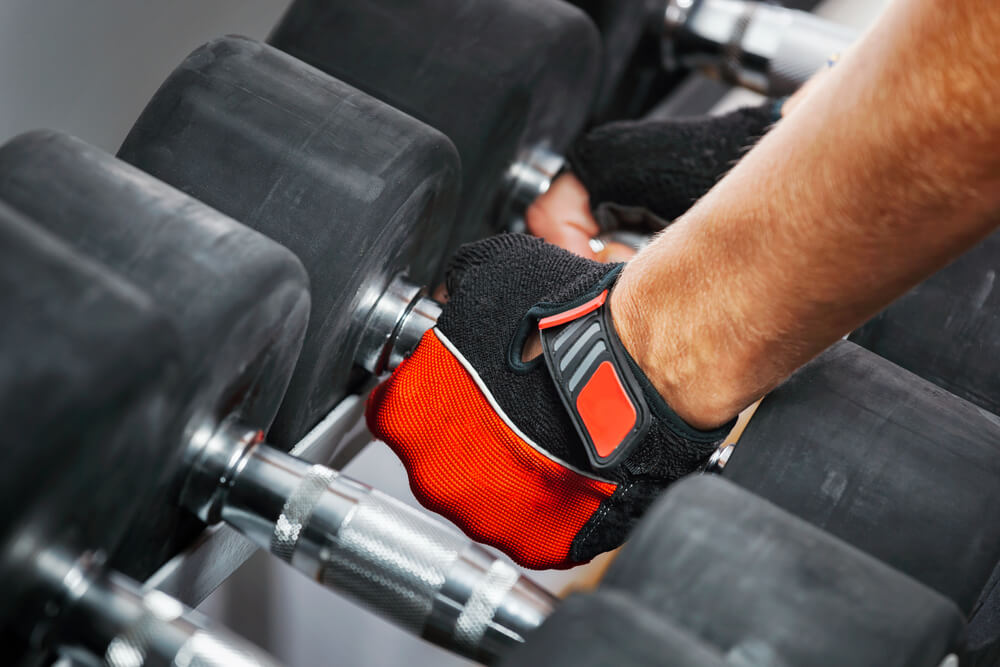
This technique might be the best bet for your gains. Here’s everything you need to know to set up your pyramid training workout.
Out of the many techniques on how to build muscle and strength, pyramid training is a staple that consistently gets better results.
It’s not an ancient Egyptian trick that’s been kept secret for centuries, but it’s still a trusted technique. Pyramid training is usually done through increasing the weight and decreasing the reps throughout sets.
While this is tried and true there are many other ways to get results from pyramid training. These are the techniques that both elite bodybuilders and athletes use.
The most effective variations are traditional, triangle and, for the advanced trainee, reverse pyramid training.
Warm Up For Pyramid Training…
You probably already use pyramid training every time you lift. Warming up and doing several light sets while building up to your working weight is, in fact, pyramid training. In this case it’s used as a warm-up both physically and mentally.
As reps are done, blood flow to the muscles under tension increases, bringing those areas oxygen and increasing heat. The involved joints also benefit greatly as the synovial fluid, the fluid that lubricates your joints, increases so that they are ready for action.
Warming-up in this fashion will also prepare you mentally.
Your body will naturally follow the tempo of the lift to the best of its ability. These sets also give you time to evaluate how your body feels that day and to clear your head to focus on the impending training session.
If this warm-up routine is foreign to you, then start using it by replicating the target amount of reps on each set while increasing the weight. The heavier the working weight, the more warm-up sets will be needed. For example, if your working set is 365 pounds on deadlifts, it would take another one or two sets to build up to this weight as opposed to a working weight of 200 pounds.
Two or three non-taxing sets will give all the benefits of the pyramid warm-up without hindering performance on the heavy sets.
Record And Conquer Your Pyramid Sets
Just like any program or method, it’s crucial to optimize results by having realistic goals.
Are you training for strength, muscle mass or endurance?
The rep scheme will be different for each of these goals.
With each type of pyramid training we discuss, you’ll find a sample of how to apply it to each of those training goals. Also, target objectives should be set ranging from each specific training session to a 12-week cycle.
Pyramid training is very taxing. It has to be approached with the proper mental attitude. Each round needs to be attacked so that the weight or reps can increase consistently. This makes tracking the sets, reps and weights used on each exercise very important for pyramid training.
Without recording this it’s very challenging to select a weight that will cause muscle failure at a specific number of reps. Continually keep a log of at least your first one or two exercises so you can track progress each week and know exactly how much weight you should be using on each set.
Rest Between Sets
Frequently, sets, reps and weight get all the glory in terms of influential factors in a workout. But all these factors lose their clout if proper rest intervals are not established or adhered to.
The lower the number of reps, and thus the higher amount of weight, the longer the body takes to recover physiologically to regain strength. This is due to the time it takes to restore ATP (energy) and primarily stored creatine in the muscle fibers. While we may feel more burn and be out of breath with higher reps, the body is actually much more capable of doing the next set with shorter rest periods.
Since the number of reps will vary between sets it’s important to keep an eye on the clock and not rest too little or too much. The samples list exactly how many seconds to rest after each set. The rest, of course, varies during the sets given that the number of reps and intensity of each set differ.
Go Big With Pyramid Training
As with any workout, certain exercises are better suited for different techniques and placement within the workout. Pyramid training is best done with larger compound exercises that incorporate multiple muscles and joints. Using pyramids on isolation exercises that target smaller muscles provides much less stimulus than compound exercises.
Furthermore, isolation exercises tend to respond best to higher reps.
Doing the same for dumbbell presses would be much more efficient and leads to infinitely greater gains.
Put simply, stick to compound movements and place them at the start of your workout for better results. Some exercises to try this and kick off workouts with are the squat, deadlift, leg press, inverted rows, lunges, chest press, rows, weighted pull-ups, shoulder workouts and overhead presses. You’ll reap the rewards from both unilateral and bilateral exercises so experiment with both.
Pyramid Training Workout
This is the most common method of pyramid training, which many people do instinctually. This method means starting with your lightest weight on an exercise and building up to heavier weights and thus fewer reps.
This method is great because it gives you time to work up to heavier weights and lessens the chance of injury. This creates an element of flexibility in the workout. It allows you to adjust weights accordingly so that each set reaches its full potential. People of all weightlifting experience levels will benefit from this method. But, those with less experience should try this method several times before building up to the more advanced and challenging pyramid schemes detailed later.
It’s important to note that there is one small caveat when using this method. Since there are multiple sets before the heaviest set, it will not give you a true idea of where your full strength levels are. As the weeks go on, you will see progress. When you do perform a higher intensity set first it, will be vastly greater then when you completed it at the end of the pyramid.
What follows are examples of how to use this method for varying goals on your opening exercise. To optimize this method you should do a one rep max test so that you know what weights to start with. It should be noted that for all examples it is best not to take every set to failure the first time. Training for muscle mass is the exception as it’s more important to train to failure to cause maximal muscle damage. As your body adapts to the training more sets can be taken to failure.
Strength
Rep scheme: 12/8/5/3/1
| Set Number | Reps | Weight: One Rep Max Percent | Rest (Seconds) |
| 1 | 12 | 65% | 90 |
| 2 | 8 | 70% | 90 |
| 3 | 5 | 85% | 120 |
| 4 | 3 | 90% | 180 |
| 5 | 1 | 95% | — |
Muscle Mass
Rep scheme: 12/10/8
| Set Number | Reps | Weight: One Rep Max Percent | Rest (Seconds) |
| 1 | 12 | 70% | 90 |
| 2 | 10 | 75% | 90 |
| 3 | 8 | 80% | — |
Endurance
Rep scheme: 20/15/12
| Set Number | Reps | Weight: One Rep Max Percent | Rest (Seconds) |
| 1 | 20 | 50% | 90 |
| 2 | 15 | 60% | 90 |
| 3 | 12 | 65% | — |
Triangle Pyramid Training Workout
This method is likely what you expected when you saw the word pyramid and is also known as “ascending descending method.” Here the weight will increase, at first, build to a maximum weight and then the weight will increase again. The inverse will happen for reps, as they’ll decrease than increase.
Given the increase and decrease, this method requires more sets. While the examples shown use five sets, this can be expanded up to 10 sets. Doing 10 sets of the same exercises is obviously very challenging.
It is reserved for training sessions that focus on getting better at one specific movement. Whether you use five sets or more, the first one or two sets shouldn’t be taken to failure.
The greater amount of volume used means that muscles will be stimulated much more than the traditional pyramid training. Your body will have to do multiple working sets with substantial weight, max out, then again perform near maximal sets, causing a huge stimulus.
Naturally after you’ve done multiple sets your body won’t be capable of doing eight reps of an exercise with the same weight as the first time you did it. You’ll notice that as the weight decreases and reps start to increase, you’ll use less weight than the first go around. If you’re able to use the same weight the second time, you’ll need to make sure to increase the weights you use the next training session.
Strength
Rep scheme: 5/3/1/3/5
| Set Number | Reps | Weight: One Rep Max Percent | Rest (Seconds) |
| 1 | 5 | 85% | 120 |
| 2 | 3 | 90% | 180 |
| 3 | 1 | 95% | 180 |
| 4 | 3 | 85% | 120 |
| 5 | 5 | 80% | — |
Muscle Mass
Rep scheme: 12/10/8/10/12
| Set Number | Reps | Weight: One Rep Max Percent | Rest (Seconds) |
| 1 | 12 | 65% | 90 |
| 2 | 10 | 70% | 90 |
| 3 | 8 | 75% | 120 |
| 4 | 10 | 65% | 90 |
| 5 | 12 | 60% | — |
Endurance
Rep scheme: 20/15/12/15/20
| Set Number | Reps | Weight: One Rep Max Percent | Rest (Seconds) |
| 1 | 20 | 50% | 90 |
| 2 | 15 | 60% | 90 |
| 3 | 12 | 70% | 90 |
| 4 | 15 | 55% | 90 |
| 5 | 20 | 45% | — |
Advanced: Reverse Pyramid Training
As advertised, there are more intense ways to use pyramid training. When comparing different methods using the same amount of volume “reverse or descending pyramid training” is the most intense.
For this method, the first set will be the heaviest, then weight will decrease just enough so you can still complete roughly the same number of reps. It can be thought of as a delayed dropset. That’s where you lower the weight just enough to keep going, maximally taxing your muscles each set.
The decrease in weight needs to remain very small so that you ensure you still hit failure without doing too many reps. Lowering the weight by 2.5% will put you in that range. Rarely will the weight be lowered as much as 5%.
Yes, this means you’re inevitably going to be whipping out the little 2.5-pound plates. What you once thought of as a Christmas tree ornament will be a tool imperative to getting you the best results. Don’t dwell on it too much. The strongest people in the world use them to make sure they’re doing exactly the weight they want. After all, you can’t lift a flat 500 pounds without using the 2.5-pound plates.
After you slide on those big plates, get a spotter. These sets are very tough and you will need someone there to make sure you don’t crumble to the ground squatting. Getting a touch of help on the last rep is fine. But, using the spotter to do forced reps will ruin the method and alter the weights you use too much. Man up and do your own reps. Just be smart about it.
Even though the examples list one specific target rep, if you’re pushing sets to failure, it will be very tough to hit the exact rep. Do your best to stay within one or two reps of the goal.
Strength
Rep scheme: 3/3/3/3/3
| Set Number | Reps | Weight: One Rep Max Percent | Rest (Seconds) |
| 1 | 3 | 90% | 120 |
| 2 | 3 | 87.5% | 120 |
| 3 | 3 | 85% | 120 |
| 4 | 3 | 82.5% | 120 |
| 5 | 3 | 80% | — |
Muscle Mass
Rep scheme: 12/12/12
| Set Number | Reps | Weight: One Rep Max Percent | Rest (Seconds) |
| 1 | 12 | 70% | 90 |
| 2 | 12 | 67.5% | 90 |
| 3 | 12 | 65% | — |
Endurance
Rep Scheme: 15/15/15
| Set Number | Reps | Weight: One Rep Max Percent | Rest (Seconds) |
| 1 | 15 | 55% | 90 |
| 2 | 15 | 52.5% | 90 |
| 3 | 15 | 50% | — |
Sample Pyramid Workout: Chest, Shoulders, and Triceps
Start by choosing any variation of pyramid training for the first exercise. This example uses reverse pyramid training.
Do a thorough warm-up with dynamic stretches and light warm-up sets
1a. Dumbbell Bench Press 3×12/12/12 (Using the reverse pyramid scheme)
2a. Incline Bench Press 3×10
3a. Seated Overhead Dumbbell Press 3×10 (Superset)
3b. Cable Chest Flye 3×15
4a. Close Grip Bench Press 3×10 (Superset)
4b. Dumbbell lateral raises 3×12
5a. Lying Triceps Extension 3×12
5b. Dumbbell bent over rear deltoid raises 3×15
Cool-down with muscle specific stretches and five minutes of low-intensity cardio.
Conclusion
Always optimize your training and use of the pyramid methods by tracking your workouts. Begin using these techniques right away and you will undoubtedly get better results in the gym.
Start today!
By Raphael Konforti, MS, CPT
Latest posts by Raphael Konforti (see all)
- The Best 4 Day Workout Split For Greater Gains - Feb 6, 2017
- The Best Lower Chest Workout For A Better Body - Aug 15, 2016
- How To Get Rid Of Shin Splints - Jul 7, 2016












[…] http://gymjunkiesmain.wpengine.com/pyramid-training-for-better-results/ […]
[…] When these things are in check, it becomes easy. Then you are able to consistently keep yourself or your clients motivated, and most importantly, produce consistently results. […]
[…] When these things are in check, it becomes easy. Then you are able to consistently keep yourself or your clients motivated, and most importantly, produce consistent results. […]
[…] Once these things are under control, it becomes easy. Then you are able to keep yourself or your clients motivated and most importantly you are able to produce consistently the results. […]